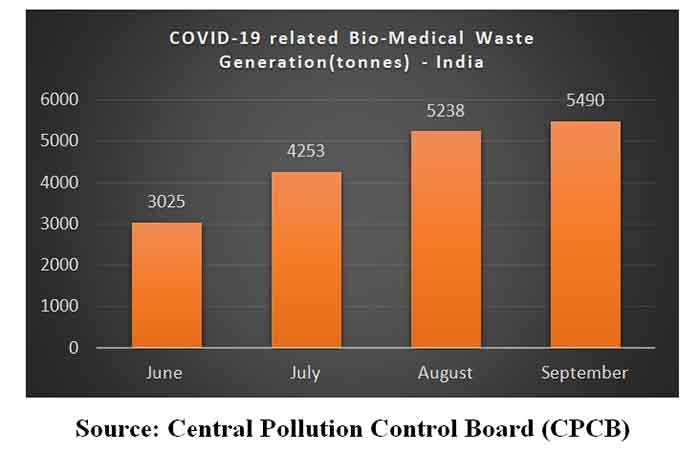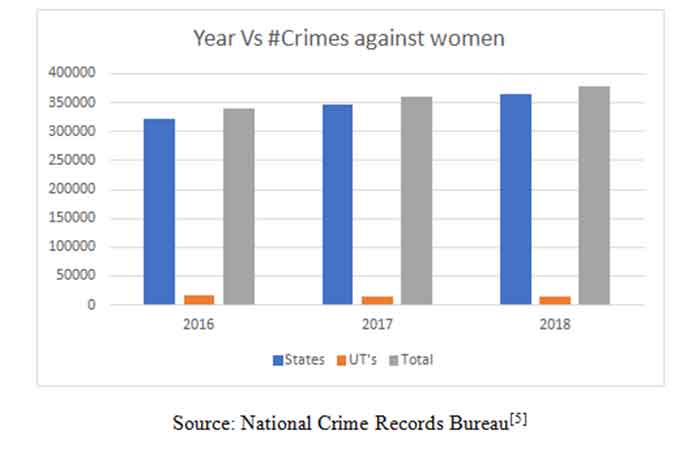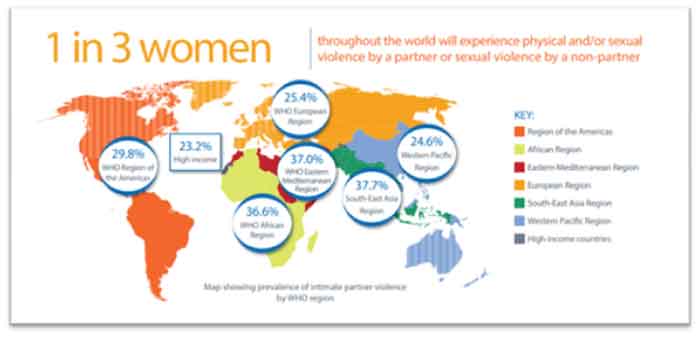Aastha Dhiman, Mitesh Rajput & Ravneet Kaur
Solid waste management in India is one of the most misunderstood topics in the country. It is one of the most pertinent issues due to the wave of rapid urbanization and subsequent lifestyle changes that come across along with it. The per capita waste generation of urban areas in India is around 200-600 grams per day. This waste includes different types of garbage that are not appropriately segregated at the point of generation and, therefore, never get adequately treated in the following cycle.
The municipal corporations in India define specific guidelines for disposal, segregation, and collection of solid wastes. Solid Waste Management Rules 2016 focus on segregation of waste at source, responsibility on the manufacturer to dispose of sanitary and packaging wastes, user fees for collection, disposal, and processing from the bulk generator.
Despite significant development in social, economic, and environmental areas, Solid Waste Management (SWM) remains a significant problem in India. The informal sector has a crucial role in managing and extracting value from this waste. Approximately 90% of residual waste is currently dumped in landfills rather than disposed of adequately at appropriate sites. Current SWM systems are inefficient. Only about 70-80% of the municipal waste gets collected, and only 25 % of this waste is processed and treated. The untreated waste has a negative impact on public health, the environment, and the economy. Many urban local bodies opt for capping of landfills so that the waste does not cause harmful health hazards. But landfills without bottom liners and sideliners allow the leachates originating from waste to seep into the ground and cause groundwater pollution.
Most of India’s significant organizations currently do not have separate dustbins for disposal of biodegradable, non-biodegradable, and paper waste. Even if some organizations try to do it, at the collection points, these wastes tend to get accumulated again due to a lack of proper value chains in the waste management system. This also happens due to the lack of implementation of municipal policies of waste segregation. As a result, the segregated waste again adds up in landfills.
Therefore, each category of waste should be segregated at the point of discard so that treatment is easy and none of it gets piled up in the dump yards.
- The most common form of waste that all households generate in an urban scenario is kitchen waste. Most of this waste is biodegradable, and hence this should be segregated in the kitchen separately from the non-biodegradable wastes. The appropriate method to dump this waste is to have an organic compost (preferably a minimum of 12 feet deep) and compost the waste after dumping.
- The second type of waste most generated in the urban scenarios is the biomedical waste. This is mostly generated by hospitals, pharmacies, and left-over medicines at homes. While some of this waste is not harmful, most of it consists of syringes, solutions, and other toxic waste that is not suitable for landfills. Sadly, most of this waste ends up in the open and is prone to spread diseases and harm stray animals. The most common treatment for such wastes is to incinerate the harmful chemical and biomedical waste. Approximately 90% of regulated medical wastes are suitable for autoclaving, particularly microbiological wastes. Gas sterilization, chemical disinfection, and microwave disinfection are other prominent forms of medical waste disposal. While disposing of such wastes, one thing to be kept in mind is that these techniques require more capital investment. Hence, the waste generators might not be willing to segregate the wastes at the point of generation and send them to appropriate disposal centers.
- Thirdly, plastic, glass, or other materials are generated in the house as non-biodegradable wastes. These wastes generally are not segregated material-wise at the point of generation. However, after collection, these are classified and can be sent to appropriate recycling plants by the type of material.
- The fourth type of waste most generated in urban areas is the e-waste. Since we have started using technology at each point in our lives, and fast-moving gadgets are flooding the market, e-waste has become a large part of urban waste generation. However, there are not enough disposal mechanisms known to the common population. Most of the e-waste can be recycled, refurbished, resold, or salvaged. Suppose the electronic component or device cannot be reused. In that case, it is prudent to recycle the materials present in the waste at designated recycling plants meant specifically for such electronic wastes.
Therefore, at the household level, there needs to be proper segregation and disposal of wastes so that all these kinds of waste can be managed and treated appropriately. Article 51 A of India’s Constitution says that it is the fundamental duty of every citizen of India to protect and improve the natural environment, including forests, lakes, rivers, and wildlife.
Most of the waste management sector initiatives focus more on cleaning, but we need to understand that cleaning and waste management are two different concepts. Hence, we further look at some of the rules defined by law that regulate SWM policies in the country.
Solid Waste Management Policy Change
The Solid Waste Management Policy was changed after 16 years in 2016 to include segregation of waste at the source. This is done such that there could be recovery, reuse, recycle.
The responsibility is on the waste generator to segregate the waste into three categories.
- Biodegradable Waste
- Dry Waste (Plastic, paper, wood)
- Domestic Hazardous (Sanitary Napkins, cleaning agents)
- Brands: All the bodies (Institutional, hotels, event organizers) are responsible for the waste segregation at the source. Some directions are given to brand owners, too, to reduce the generation of waste. Sanitary Napkin brand has been directed to increase awareness for the disposal and ensure a proper disposal mechanism (like providing a bag for disposal) for their product. Brands that generated packing non-biodegradable waste (Food & beverage industry) are directed to set up a system to collect back the plastic waste generated.
- Fines: Municipal Authorities have been given the freedom to levy penalties for non-segregation of the waste. It is mandated not to bury or burn the waste on public premises. A waste processing facility is to be set up by all local bodies with a population of more than 1 Mn within two years of time.
- Waste to Energy: Non-Recyclable waste could generate energy used in manufacturing processing plants or thermal power plants. The Ministry should create an infrastructure to give incentives or put a minimum cap for the industry to use such waste to create an effective circular economy framework.
- Landfills: The landfill sites should be away from rivers, ponds, highways, and habitable areas. The emission standards have been made stringent. Construction of landfills on the hills has to be avoided. Sanitary Landfills could be there in plain areas. However, processing facilities are functional in hilly areas.
Implementation Issue of Solid Waste Management
The main issue is the garbage; instead of getting treatment keeps on rising in the landfill. The municipal bylaws have not changed in the new policy; the municipal corporation could evade responsibility from mandatory waste collection.
One of the significant issues is that the people who collect the waste by going from door to door do not segregate the waste as they are not integrated in the system & do not have proper education or training. The problem at the consumer end who is responsible for the generation of waste is that they do want clean surroundings and prefer garbage not piling up. Still, the issue is they are reluctant to put effort into segregating waste.
Swachh Bharat Mission was started in 2014 with the mission of making India Clean. Solid waste management as part of its mission and the government has taken several measures for it. In one of the case studies of SWM in Solapur, Maharashtra, the research found that 20% of the waste generated in a day remained uncollected. This directly affects human living conditions. Most of the waste-collectors van are open vehicles carrying waste, creating a nuisance of odor & smell as they travel across the city. Significant waste is collected from community bins & commercial establishments.
The waste, when collected, is dumped in the landfill. The landfill site maintenance is deplorable in India. Most of the waste dumped on open. The lack of maintenance of landfills affects the groundwater leading to its contamination because of leachate percolation.
The workers are affected at each level who are responsible for solid waste management. They face health hazards and also injuries because of dealing with sharp scrap material. The workers are more prone to respiratory diseases like asthma & T.B. The workers involved in loading garbage face eye infection problems. The rag pickers suffer from all kinds of pathogenic diseases and are not entitled to the medical facility for their health issues. They hardly earn enough to sustain their two times meal in a day. They are not accepted by society & the irony is they are termed as “Kachrawala” whereas they are the ones cleaning the surrounding.
Also, in the current times of Covid, medical waste is an alarming concern that needs to be handled even before covid medical waste has been a concern for the nation. According to the Central Pollution Control Board (CPCB), India generates 559 tonnes of biomedical waste a day. 7% of daily medical cannot be processed, that is around 15000 tonnes a year. It is going to lead to a biohazard if the waste is not processed. Some of the infections caused by bio-waste are gastrointestinal, respiratory, Hepatitis, AIDS, etc. Even after a policy change, there are not strict measure in case someone violet rules. Only a show-cause notice or suspension of license is possible. Many projects remain stuck because of the lack of coordination between the environment ministry, CPCB & state level agencies to identify land for the processing waste.
The residential sector is generating more medical waste. The significant contribution is sanitary pads, earbuds or contaminated objects with blood. The government should come up with stringent medical waste regulations too and also promote industry & startups to take up the challenge of handling Medical waste. In the COVID-19, India has generated 18000 tonnes of bio-medical waste in 4 months.

Source: Central Pollution Control Board (CPCB)
The issue is all about the lack of awareness & reluctance of people. Mixing of general solid waste with biomedical waste would result in an additional load on Common Bio-medical Waste Treatment Facilities (CBWTF) incinerators, which are not designed for domestic solid waste. Recyclables that can be stored by isolating it for 3-5 days can be stored & reused. Many people do not know about it, and then through every bio-medical waste into the Yellow bins. The policy needs to rethink the Refuse, Reduce & Recycle policy in the Healthcare sector waste management. Non-segregation of bio-waste with dry waste is leading to a huge crisis.
Changes required to improve solid waste management/new ways of SWM.
Solid waste management policy was implemented to handle the informal sector better and formalize waste collection management. Without a doubt, there has been a lot of improvement in terms of the policy. A new rule has a wide scope of areas covering municipal areas and urban agglomeration, census towns, notified industrial townships, areas under the control of Indian Railways, airports, SEZs, and places of pilgrimage.
Even after the implementation of SWM, still a lot could be done to improve Solid waste management in India. Some points are mentioned below
Decentralization of waste management – New policy has focused on the centralized committee, but the current system requires a strong and independent and decentralized waste management authority to regulate waste management. Without clear regulation and enforcement, improvements will not happen. Strong waste regulations can drive innovation.
For ex- Ambikapur in Chhattisgarh and Vellore present an excellent example of the same where the waste was collected in a decentralized manner, composted naturally, and is planted.
Attitude & behavior change for waste management – No matter how many policy reforms are on paper. Still, no policy will be successful if the masses do not become a part of it. In order to bring a fundamental shift in public mindset and behaviour towards producing less trash and not littering. Masses should be educated for behavioural change in the storage and disposal of waste. Municipal bodies should probe in media to educate the masses in the separation of waste. NGOs and community participation should be encouraged.
Training & development at an early stage– There is a need to develop training and capacity building at every level. All Indian school children should understand the importance of waste management, the effects of poor waste management on the environment and public health, and everyone’s role and responsibilities in the waste management system. This will develop responsible citizens who regard waste as a resource opportunity.
Levy heavy penalties for not following rules – The new waste management policy fails to impose a heavy penalty on defaulters. Due to the high informal system level, it is difficult to track in case of poor implementation of rules. Also, there is no defined penalty for defaulters, rather it at the discretion of local bodies.
Financial incentives or Tax subsidies for waste management companies – There has been a surge in waste management companies. To mobilize the solid management, govt could fund SWM companies, and infrastructure must be raised from waste producers through a waste tax. Also, the govt. should push companies to take up SWM activities under CSR activities. These funding activities and incentives would probably be sufficient to mobilize the masses for effective waste management throughout India.
Laying down explicit technical norms: It is imperative to make Bio-mining and Bio-remediation compulsory for areas wherever it can be applied because it is one of the most effective processes & eco-friendly. Use of these processes should not be kept at the discretion of local bodies, and rather an independent body should be responsible for deciding the geographical constraints that could prevent the use of the techniques mentioned above.
The decision-makers at all levels of government must opt for more innovative and green approaches rather than falling for the technology-extensive costly methods of waste disposal, which usually are being lobbied for by the manufacturers of such technologies.
Some exceptional case studies of other countries
Case study 1.0 – An artificial island in Singapore (Semakau Landfill: Not Just A ‘Rubbish Island’)
The ‘landfill’ world automatically brings a picture of a smelly garbage mountain to mind because that’s what it usually is. A landfill converted into a bio-diverse hotspot is now home to vibrant mangroves, rich coral reefs, and capital of birds and marine life. The Semakau Landfill is the first offshore landfill in Singapore is designed to protect the natural environment that resulted in an eco-park.
In India, offshore landfills are a great win-win for coastal cities, provided that enough island space is available or there is scope for artificial islands. Also, the Waste to Energy concept of Sweden is an amazing initiative, and if clean energy can be produced, the method can be utilized to electrify rural India and tier 2,3 cities where electricity is a problem.
Case study 2.0: Trading Trash for free Health care
In Malang, Indonesia, 55000 tonnes of waste every day. People living in the city did not have health insurance. Medika, a healthcare company, created clinical insurance that will allow people to exchange garbage for medical services and medicines.
In India, a similar approach could be taken to provide health insurance for the people to exchange their waste in rural and urban regions. This will tackle poverty & also waste problems in the country. This will increase the percentage of recycling waste in India.
Conclusion
The population growth, and especially the creation of megacities, is making SWM a major problem in India. The current situation is that Informal Indian SWM has insufficient waste treatment and dumping facilities. There are significant problems associated with public engagement in waste management, and there is typically a lack of accountability in the community for waste. There is a need for community knowledge to be cultivated and people’s attitudes towards waste to be improved, as this is important for implementing proper and sustainable waste management systems. Sustainable and economically viable waste management combined with the safe disposal of residual waste through the construction of engineered landfills and waste-to-energy installations will ensure maximum resource production from waste. India is facing problems relating to waste policy, the selection of waste technologies, and the availability of adequately qualified people in the waste management industry. India will continue to suffer from inadequate waste management and the effects on public health and the environment until these essential criteria are met.
The dramatic shift in how waste management regimes operate in India will take more than 4-5 years. The 2016 SWM rules lower the hope for the implementation of a decentralized solid waste management mechanism. It will, however, be challenging to see how source segregation functions on the field. To press for better enforcement of these laws, a major awareness campaign needs to be planned in association with governments, NGOs, students, and other stakeholders. The rules need to concentrate on making solid waste management a people’s movement by bringing the problems, concerns, and management of solid waste to residents and grassroots.



